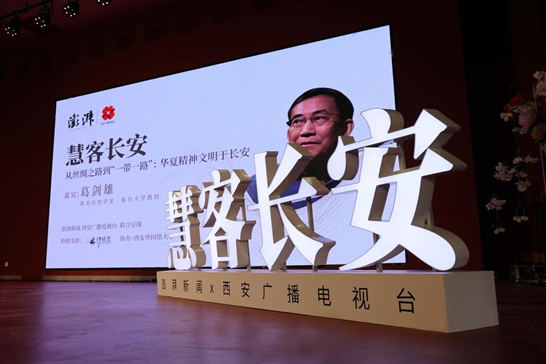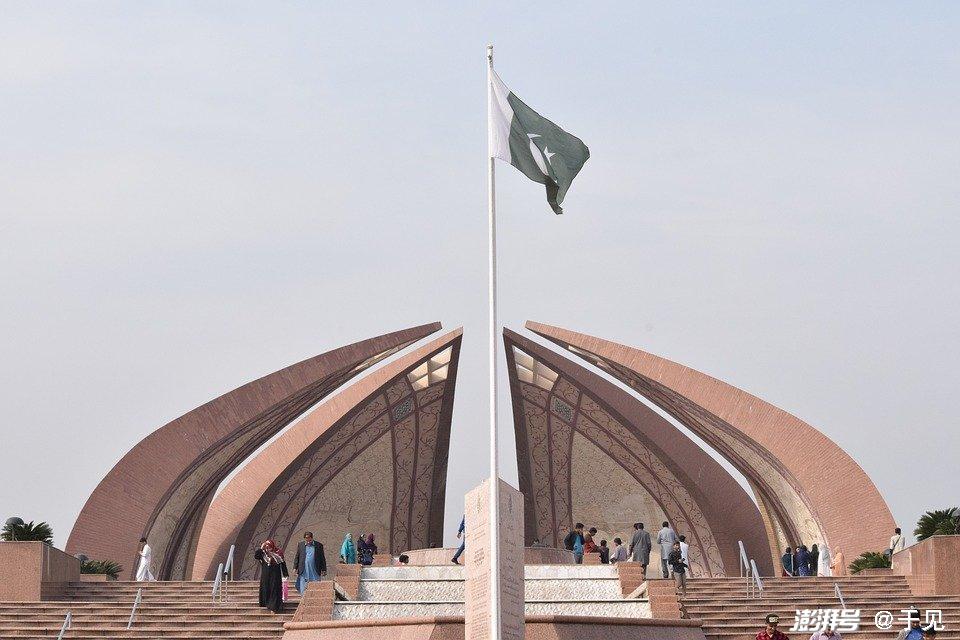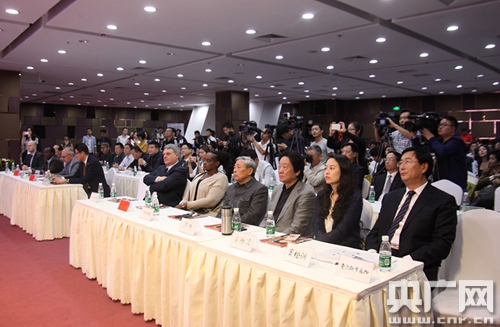A River Of Han River Carries The Cultural Heritage For Thousands Of Years And Enters The Present Dynasty
A River Of Han River Carries The Cultural Heritage For Thousands Of Years And Enters The Present Dynasty
A river of Han River carries the cultural heritage for thousands of years and enters the present dynasty
In Hanzhong, Shaanxi, when the summer breeze wrapped around the fragrance of rice dumpling leaves, a cultural dialogue spanning thousands of years is quietly unfolding.
On May 31, in the exhibition hall of the Hanzhong Museum's "Qingjian Falling Shadow - Bronze Mirror Collection Exhibition", more than ten primary school students sat around the social teacher, listening to her telling the history of Dragon Boat Festival casting mirrors that began since the Tang Dynasty. The interesting stories deeply attracted the children.
During the Dragon Boat Festival holiday, Hanzhong was immersed in a strong cultural atmosphere, and a series of exciting cultural activities were vigorously carried out. From the kids who focus on listening to history in the museum to the lively scenes of folk performances in the streets and alleys, Hanzhong is bringing traditional culture into public life in a unique way.
In July 2023, General Secretary Xi Jinping emphasized during his inspection in Hanzhong, Shaanxi that cultural relics carry splendid civilization, inherit historical culture, and maintain national spirit. We must give full play to the important role of museums in protecting, inheriting, researching and displaying human civilization, protect the Chinese cultural context, and make cultural relics come alive and expand the influence of Chinese culture. Intangible cultural heritage such as Hanzhong rattan is well-known for its long-standing reputation. We must develop and strengthen characteristic industries to better drive people to increase their income and become rich.
Hanzhong is named after the Han River and is known as the "Birthplace of the Han family and the treasure pot of China". In recent years, Hanzhong has insisted on "protection, inheritance, research and display", and has promoted cultural relics protection, cultural heritage, cultural tourism integration, and industrial development in an integrated manner, and written the "Hanzhong answer sheet" for cultural heritage and development in the new era.
Recently, a group of Guangming Daily research teams came to Hanzhong, touched the pulse of history at the ancient Han platform, perceived the vitality of innovation in the intangible cultural heritage workshop, and explored the vigorous vitality of cultural heritage inheritance and development in this hot land that is immersed in the legacy of the Han and the Three Kingdoms.
1. Protection: Let cultural heritage burst into the glory of the times
"The bronze mirrors of the Warring States Period are simple and simple, the bronze mirrors of the Han Dynasty are solemn and grand, and the bronze mirrors of the Tang Dynasty are gorgeous and exquisite..." On June 10, Yuan Jing, a tour guide at the Hanzhong Museum, was introducing the bronze mirror styles of different periods to tourists. These civilization marks that travel through time and space vividly reflect the changes in the aesthetics and emotions of the Chinese nation over the past thousand years.
In the midsummer Hanzhong Museum, the ancient Hantai Pavilion District hidden by ancient trees is quiet and solemn. 72 cultural relics from the Qin, Han, Tang and Song dynasties were unveiled at the "Qingjian Falling Shadow - Bronze Mirror Collection Exhibition". The faint light reflected by the bronze mirror not only allows tourists to see the universe view of the cloud and thunder pattern of the "Seven Breasts Inscription Mirror" of the Han Dynasty and the "Sky-round and Place" behind the divine beast shape, but also see the blend of Silk Road culture contained in the complex patterns on the "Sea Beast Grape Mirror" of the Tang Dynasty.
Behind this exhibition is the preparations of the Hanzhong Museum’s cultural relics protection team for several months. "We must display excellent cultural relics in the collection, and let tourists understand and remember them." said Lu Hui, director of Hanzhong Museum.
Since the end of 2023, the Hanzhong Museum has conducted two-dimensional and three-dimensional digital collections of nearly 300 precious cultural relics, focusing on promoting the digitalization of cultural relics, and preparing for the unified management of cultural relics resources in the future. Due to the different patterns, texts and craftsmanship of cultural relics, at most, the staff took 1,600 photos of a cultural relics, recording the details of each place in all aspects.
"Take the digital guide of the "Three Colored Lotus Lantern Maid's figurine" that I am editing. We must not only clarify the historical background, but also compare the characteristics of similar collections in major museums, focusing on the shape of cultural relics, patterns and other artistic expression techniques, as well as the political, economic and cultural conditions of society at that time." Wang Yaqian, head of the Hanzhong Museum Business Section, told the research team.
On International Museum Day on May 18, 2024, Hanzhong Museum successfully ranked among the national first-class museums, filling the gap in southern Shaanxi where there are no national-level museums.
"Hi, hi, hi, hi, hi..." In the music class of Jingyang Junior High School in Zhenba County, Hanzhong City, the young men in their prime performed the newly compiled folk song "What's the best in the mountain song". "Let nursery rhymes become the seeds of cultural enlightenment," said Tang Chenggang, a music teacher at the school.
"Hanzhong and southern Shaanxi folk songs record humanistic historical changes, the life situation of the times, customs and etiquette, and are precious wealth that cannot be forgotten." Xu Hongju, director of the Hanzhong Municipal Bureau of Culture and Tourism, said. In 1984, the Zhenba County Cultural Center conducted a census of Zhenba folk songs and published "Zhenba Folk Songs Collection", which opened the curtain for the protection and development of Hanzhong and southern Shaanxi folk songs.
In 2005, the Hanzhong Municipal Party Committee and Municipal Government held the first Shaanxi Folk Song Festival. In June 2008, Zhenba folk songs were included in the second batch of national intangible cultural heritage list. In 2009, Zhenba County was awarded the title of "Hometown of Chinese Folk Culture (Folk Song) Art" by the Ministry of Culture. On March 1, 2025, the "Regulations on the Protection, Inheritance and Development of Hanzhong Southern Shaanxi Folk Songs" was officially implemented, marking that the protection, inheritance of Hanzhong Southern Shaanxi Folk Songs has entered a new stage.
"Protection is not about sealing, but about allowing the cultural gene to be passed on forever." Gao Quan, deputy director of the Hanzhong Intangible Cultural Heritage Protection Center, introduced that there are 10 representative inheritors of Zhenba folk songs in Hanzhong City, and more than 3,000 people can sing Zhenba folk songs. In 2019, Hanzhong City also established the Shaanxi Southern (Zhenba) Folk Song Inheritance Base, Peng Guangqin Shaanxi Southern Folk Song Studio, etc., to support representative inheritors to teach apprentices and pass on their skills.
In Qingshui Town, Zhenba County in the early morning, Tian Hongtao, the provincial intangible cultural heritage inheritor, led his disciples to the misty Guanyun Mountain. As the sheepskin drum sounded, the song of "Zhenba Fishing Drum" penetrated the sea of clouds, and the wisdom of a thousand-year-old farming civilization flowed in the song. "Every lyric is a living farming textbook, teaching solar terms, preaching agricultural techniques, and ethics." Tian Hongtao said that these labor songs originated from the Qin and Han Dynasties, and now have new descendants.
2. Inheritance: The road to rebirth of intangible cultural heritage skills
A rattan and a pair of scissors, the fingertips danced with their fingertips. Within thousands of twists and turns, the flexible rattan turned into exquisite items such as waist baskets, fishing gear, chairs, etc. Hanzhong rattan weaving is a utensil with a rattan bamboo structure or a pure rattan structure with green vine as the basic weaving material and is completed using a variety of weaving techniques. "Hanzhong Regional Chronicles" records that "there are rich resources of bamboo, rattan, brown and grass in the territory, and the hand-woven history has a long history." In 2021, Hanzhong Vinegarbha was included in the national intangible cultural heritage project list.
When you walk into Huangguan Town, Nanzheng District, Hanzhong City, which is known by the locals as the "hometown of rattan weaving", almost every household here is familiar with rattan weaving skills. "In the early 1970s, my father led the whole family to independently produce some daily rattan products, and went from street to street for sale. At the same time, he provided technical guidance to the surrounding villagers and encouraged them to actively participate in rattan products weaving." Chen Liangshun, the provincial representative inheritor of Hanzhong rattan, introduced.
From the beginning of production alone, to the fact that more than a dozen villagers worked together, to the establishment of professional cooperatives and companies, "small business" has gradually become a "big business". Liangshun Tengbian Cooperative (Shaanxi Liangshun Jianxin Industrial Co., Ltd.) adopts the development model of "company cooperative base farmers e-commerce", which has driven nearly 2,800 people in 1,200 households and other surrounding towns such as Huangguan and Qingshu to find flexible employment and increase income. It produces 220,000 pieces (sets) of various handmade products annually, with an annual output value of about 80 million yuan.
"The small brown-woven fan in my hand is not only a representative national-level intangible cultural heritage project product, but also a foreign trade product ordered by a luxury brand..." In the e-commerce live broadcast room, the anchor is concentrating on promoting ivy-woven products. It is reported that Hanzhong rattan products are not only sold well in the country, but are also sold to Europe, America, Southeast Asia and other places.
When traditional skills and the wave of the times happily embrace each other, the tempered fingertip skills have gone from the countryside to the world, not only weave a path of industrial integration, but also weave a "happiness network" for the people. "Hanzhong Vinegar Intangible Cultural Heritage Workshop to Help Rural Revitalization" was successfully selected as the UNESCO 2024 "Intangible Cultural Heritage Promoting Sustainable Development" case in the Asia-Pacific region.
"Since you can speak and speak, I want to ask about all kinds of flowers..." Every weekend night, the post-00s Han Chinese actor Li Yazhi will start broadcasting on time in the live broadcast room.
As a national intangible cultural heritage, Han Diao Gua is a national intangible cultural heritage that combines various opera elements such as Qin Opera and Han Diao Erhuang, and is mainly popular in the Hanzhong region. During its heyday, there were more than 120 theaters and more than 1,500 plays in Han Diao, which were spread to Hubei, Guangdong, Guangxi, Yunnan and Guizhou. Today, only one of the live-action performance units in Hanzhong City, Nanzheng District, Hanzhong City has remained in Hanzhong City.
From joining the group at the age of 13 to becoming a live broadcast at the age of 24, Li Yazhi's decades of solid training have become her confidence in attracting traffic. During this year's May Day, she moved her live broadcast room to the campus square and the village cultural square. One after another, the fine interludes and comprehensive songs and dances were staged one after another, and the Han Dianzi is being seen by more people.
Exploring the multiple values of cultural heritage makes traditional culture no longer shelved, but enters the daily lives of the masses. Hanzhong has always focused on the participation of the whole people and public experience, and has carefully created more than 40 high-quality cultural tourism routes of "wearing Hanfu, practicing Chinese characters, and performing Han rituals", integrating local culture into more than 3,000 mass cultural activities every year, so that the genes of civilization can be endless in daily fireworks.
3. Research: Building a framework for historical and cultural research
"In October 2023, the Hanzhong Municipal Party Committee held a conference on historical and cultural heritage and development, and clearly proposed to implement the "Zhong" cultural research project that vertically connects various historical eras in Hanzhong and focuses on the "Two Han and Three Kingdoms"." Li Chao, deputy director of the Propaganda Department of the Hanzhong Municipal Party Committee, carefully explained to the research team what is the "Zhong" cultural research project - the "vertical" representative of the "Zhong" character should carry out a comprehensive research, and the "mouth" is to focus on the key historical periods of the "Two Han and Three Kingdoms" in Hanzhong to carry out research.
The systematic construction of a historical and cultural research framework from the level of the Party Committee and the government shows how determined and the intensity are. Hanzhong has a rich history and culture. From the Book of Songs to the Book of Han, from Zhang Qian to Zhuge Liang, from Li Bai, Du Fu to Wentong and Lu You, from the "land that military strategists must fight for" to the land where the Northwest United University is settled, Hanzhong has stirred up brilliant waves in the long river of history.
Xu Xiangyang, dean of the School of Humanities of Shaanxi University of Science and Technology and dean of the Hanzhong Han Culture Research Institute, said that the "Zhong" character culture research project has a prominent focus and the combination of points, lines and surfaces has opened a small incision for scholars to understand, understand and study Chinese traditional culture, which is conducive to the construction of the Hanzhong historical and cultural research system.
Since the implementation of the "Zhong"-shaped culture research project, Hanzhong has successively launched a number of research results, including "Hanzhong Chronicles", "General History of Hanzhong", "Hanzhong in Classics", "Hanshui Culture History" and "Poetry Talk about Hanzhong".
In recent years, Hanzhong City has organized high-level academic exchange activities such as Zhang Qian and Silk Road Summit Forum, Hanzhong Han Culture, Three Kingdoms History and Zhuge Liang Seminar, Hanzhong Shu Road and Shimen Stone Carvings, and many other national academic institutions such as the Institute of History of the Chinese Academy of Social Sciences and the China Qin and Han History Research Association have also promoted the research and dissemination of Han culture.
"In combination with the fourth national cultural relics survey, we are promoting the investigation of the current status of the cultural heritage sites of the Qinshu Ancient Road. We have completed the survey of Hanzhong regional heritage resources such as Baoxie Road, Chencang Road, Micang Road, Jinniu Road, and Lizhi Road, and are conducting a survey of Tangluo Road heritage resources." Li Ding, head of the Cultural Relics Section of the Hanzhong Municipal Culture and Tourism Bureau, told the research team.
The ancient Qinshu Road is an ancient transportation road system that crossed the Qinba Mountains and connected the north and south. "The intersection of the seven ancient plank roads of Qin and Shu Road is in the Hanzhong Basin. The Shimen at the southern end of Baoxie Road is quite famous on the Qin and Shu Road. Literature and poets of all dynasties left more than a hundred square meters of cliff carvings near the Shimen, especially the "Thirteenth Stone Gate". It not only vividly expresses the evolution of Chinese characters from seal script, clerical script and regular script, but is also an important reference for the research on Chinese transportation history, economic history, water conservancy history, art history, and calligraphy history." When talking about "Shu Road" and "Shimen", Xu Xiangyang talked endlessly.
With the inclusion of "Shu Road Archaeology" into the major project of "Archaeology China" by the State Administration of Cultural Heritage, archaeological research on the Qin and Shu Ancient Road has gradually become a popular academic topic for scholars in Shaanxi, Gansu, Sichuan and Chongqing. In recent years, Hanzhong has rescued and protected more than 200 square meters of cliff carvings, published "A Study on the Ancient Qin and Shu Road in Early China" and "Heritage of Qin and Shu Ancient Road in Shaanxi", formulated the "Implementation Plan for the Protection and Utilization of the Ancient Qin and Shu Road in the Middle Section", and actively gathered forces from multiple parties to promote the historical research and cultural heritage of Shu Road.
4. Display: From regional symbols to civilized dialogue
On May 20, the "Traveling to Shaanxi with Ancient Books" (Season 1) event launched by Shaanxi Library (Shaanxi Ancient Book Protection Center), Shaanxi Public Library Service Alliance, and libraries from all cities, districts and counties across the province on the "4.23" World Book Day. 35 "little cultural messengers" and 5 parent volunteers, with the theme of "Looking for the "Han Nan Shuan Xiu County Chronicles" and Exploring the Source of the Han Dynasty", conducted a cultural study activity in Hanzhong with the theme of "walking experience learning" in Hanzhong, which was a cultural study activity that was about Hanfu, performing Han rituals, seeking Han style, and speaking Chinese.
Hanzhong conducts more than 2,000 such cultural studies activities every year. Many cultural programs such as "Travel with Books", "Travel with Folk Songs", and "Shaanxi You Don't Know" have entered Hanzhong for recording.
The red-crowned crane is known as the "Oriental Gem". In 1981, the only seven remaining wild red-crowned cranes in the world were found in Yaojiagou, Yang County, Hanzhong, deep in the Qinling Mountains. After more than 40 years of protection and breeding, the population of red-crowned cranes has exceeded 10,000.
In East Asian culture, the red-crowned crane has a high status. In ancient times, it was called "ibi" and because it is similar to the divine beast "Surf Bird", it is considered a symbol of auspiciousness and wealth.
Focusing on the protection and breeding of red-crowned cranes, Hanzhong deeply explores its ecological value, cultural value and diplomatic value, vividly tells the beautiful story of red-crowned crane flying to the world, and has successively held major events such as the International Forum of Red-crowned cranes and the Cultural Exchange of Red-crowned cranes, and issued "Red-crowned cranes" stamps and commemorative coins to the whole country. The "Red-crowned crane" science and education film won the China Publishing Government Award. At the same time, Hanzhong also cooperates with Japan, South Korea, Greece and other countries to slow live broadcast of the natural breeding process of red-crowned cranes, with more than 20 million viewings on the entire network.
At the Hanzhong Red Crane National Nature Reserve, the research team saw two young red cranes bred in the reserve during this year's Qingming Festival. According to Gao Jie, a breeder at the artificial breeding center of the reserve, "Dabao was born in Qingming Festival and named "Qingqing", which is the green scene of all things sprouting in spring; the second treasure was named "Yuyou", which comes from "The Book of Songs: Xiaoya" "Yuyou Deer Singing, Eating the Wild Apple", which symbolizes vitality and hope."
The research team learned that in recent years, Hanzhong has actively cooperated with key national diplomatic institutions, jointly organized the "Belt and Road" annual Chinese character release event with the China Public Relations Association, held the "Belt and Road" international triathlon for three consecutive years, and carried out ten consecutive activities for international students to perceive the Chinese culture, showing the world the unique cultural charm of Hanzhong to the world.
5. Experience and Inspiration
In recent years, Hanzhong has earnestly studied and implemented Xi Jinping's cultural thoughts, activated the "pool of spring water" of China's excellent traditional culture, and gradually explored a path of creative transformation and innovative development of excellent traditional culture that can be protected, inherited, studied and displayed.
Protect cultural treasures and inherit Chinese civilization. The local government has conscientiously implemented the new era cultural relics work policy of "protection first, strengthening management, exploring value, effectively using it, and bringing cultural relics to life", taking multiple measures and taking positive actions, keeping pace with the times and working hard for a long time, effectively safeguarding the historical authenticity, style integrity and cultural continuity of cultural relics resources, and giving precious cultural relics sustainable vitality. We will do a solid job in the protection, inheritance, revitalization and utilization of intangible cultural heritage, deeply explore the rich connotations contained in cultural heritage, innovate publicity methods, and continuously cultivate and strengthen the team of inheritors, so as to attract more people, especially young people, to understand, love and actively participate in the cause of cultural heritage protection and inheritance.
Light up cultural coordinates and serve national strategies. The ancient Qinshu Road that travels through the Qinba Mountains and the surging Han River crisscross the eastward, forming a cultural coordinate system of hardness and softness, jointly supporting Hanzhong, a national historical and cultural city. Through the protection and research of the world cultural heritage Zhang Qian’s tomb and the ancient Qinshu Road cultural heritage, it is integrated into the western development strategy and the construction of the "Belt and Road"; through the study of the humanistic ecological value of the Qinling Mountains and the Han River culture, it serves the national South-to-North Water Diversion Project, demonstrating the location advantages of Hanzhong in the north and south, and better serving the national strategy.
Improve institutional design and enhance cultural confidence. Since the local government launched the "Hanzhong Historical and Cultural City Protection Plan" (2021-2035), and promoted the implementation of the "Implementation Opinions on Strengthening Historical and Cultural Inheritance and Promoting Cultural Prosperity and Development", "Implementation Plan for Strengthening the Inheritance and Development of Han Culture to Create a Cultural Research Highland of "Two Han and Three Kingdoms"", the system design has been improved from the aspects of policies, projects, funds, etc., and written the "Hanzhong Answers" for the cultural heritage and development of the new era. Traditional culture moves towards the public eye with a vivid and tangible appearance and continues to enrich people's lives. In the process of improving satisfaction and sense of harvest, the masses will enhance their cultural confidence.
Innovate cultural formats and tell good Chinese stories. With the deepening of economic globalization and informatization today, the development of new quality productivity is an inherent requirement and important focus for promoting high-quality development and an important factor in economic growth. Through three-dimensional digitalization of cultural relics, AR virtual roaming, live streaming and other means, the local government allows millennium cultural relics and intangible cultural heritage to embrace the times. Through the cross-border integration of "culture tourism", "culture education", "culture technology", etc., it expands the contemporary narrative space of traditional cultural context, tells Chinese stories well through international expressions, forms a dissemination path of "local characteristics - national symbols - world language", and uses new qualitative productivity to activate new cultural formats, expand the influence of Chinese culture, and actively builds a bridge for dialogue between regional culture and world civilization.
(Author: Guangming Daily Research Group, members of the research group: our reporters Zhang Zhehao and Li Jie, Li Zhankui, Dean of the School of Marxism of Shaanxi University of Technology, and Liang Zhongxiao, Director of the Qinling and Shudao Culture Research Center of Shaanxi University of Technology)
" style=":none">





